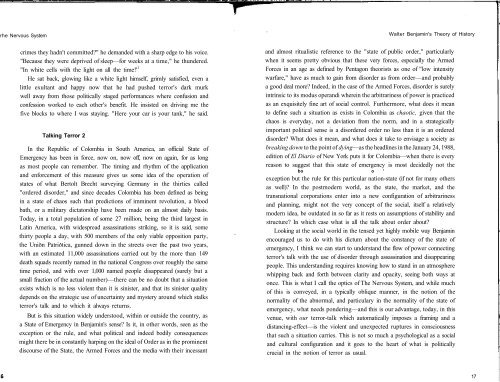The Nervous System - Department of English and Comparative ...
The Nervous System - Department of English and Comparative ...
The Nervous System - Department of English and Comparative ...
You also want an ePaper? Increase the reach of your titles
YUMPU automatically turns print PDFs into web optimized ePapers that Google loves.
he <strong>Nervous</strong> <strong>System</strong><br />
Walter Benjamin's <strong>The</strong>ory <strong>of</strong> History<br />
crimes they hadn't committed?" he dem<strong>and</strong>ed with a sharp edge to his voice.<br />
"Because they were deprived <strong>of</strong> sleep—for weeks at a time," he thundered.<br />
"In white cells with the light on all the time!' 1<br />
He sat back, glowing like a white light himself, grimly satisfied, even a<br />
little exultant <strong>and</strong> happy now that he had pushed terror's dark murk<br />
well away from those politically staged performances where confusion <strong>and</strong><br />
confession worked to each other's benefit. He insisted on driving me the<br />
five blocks to where I was staying. "Here your car is your tank," he said.<br />
Talking Terror 2<br />
In the Republic <strong>of</strong> Colombia in South America, an <strong>of</strong>ficial State <strong>of</strong><br />
Emergency has been in force, now on, now <strong>of</strong>f, now on again, for as long<br />
as most people can remember. <strong>The</strong> timing <strong>and</strong> rhythm <strong>of</strong> the application<br />
<strong>and</strong> enforcement <strong>of</strong> this measure gives us some idea <strong>of</strong> the operation <strong>of</strong><br />
states <strong>of</strong> what Bertolt Brecht surveying Germany in the thirties called<br />
"ordered disorder," <strong>and</strong> since decades Colombia has been defined as being<br />
in a state <strong>of</strong> chaos such that predictions <strong>of</strong> imminent revolution, a blood<br />
bath, or a military dictatorship have been made on an almost daily basis.<br />
Today, in a total population <strong>of</strong> some 27 million, being the third largest in<br />
Latin America, with widespread assassinations striking, so it is said, some<br />
thirty people a day, with 500 members <strong>of</strong> the only viable opposition party,<br />
the Union Patriotica, gunned down in the streets over the past two years,<br />
with an estimated 11,000 assassinations carried out by the more than 149<br />
death squads recently named in the national Congress over roughly the same<br />
time period, <strong>and</strong> with over 1,000 named people disappeared (surely but a<br />
small fraction <strong>of</strong> the actual number)—there can be no doubt that a situation<br />
exists which is no less violent than it is sinister, <strong>and</strong> that its sinister quality<br />
depends on the strategic use <strong>of</strong> uncertainty <strong>and</strong> mystery around which stalks<br />
terror's talk <strong>and</strong> to which it always returns.<br />
But is this situation widely understood, within or outside the country, as<br />
a State <strong>of</strong> Emergency in Benjamin's sense? Is it, in other words, seen as the<br />
exception or the rule, <strong>and</strong> what political <strong>and</strong> indeed bodily consequences<br />
might there be in constantly harping on the ideal <strong>of</strong> Order as in the prominent<br />
discourse <strong>of</strong> the State, the Armed Forces <strong>and</strong> the media with their incessant<br />
<strong>and</strong> almost ritualistic reference to the "state <strong>of</strong> public order," particularly<br />
when it seems pretty obvious that these very forces, especially the Armed<br />
Forces in an age as defined by Pentagon theorists as one <strong>of</strong> "low intensity<br />
warfare," have as much to gain from disorder as from order—<strong>and</strong> probably<br />
a good deal more? Indeed, in the case <strong>of</strong> the Armed Forces, disorder is surely<br />
intrinsic to its modus oper<strong>and</strong>i wherein the arbitrariness <strong>of</strong> power is practiced<br />
as an exquisitely fine art <strong>of</strong> social control. Furthermore, what does it mean<br />
to define such a situation as exists in Colombia as chaotic, given that the<br />
chaos is everyday, not a deviation from the norm, <strong>and</strong> in a strategically<br />
important political sense is a disordered order no less than it is an ordered<br />
disorder? What does it mean, <strong>and</strong> what does it take to envisage a society as<br />
breaking down to the point <strong>of</strong> dying—as the headlines in the January 24, 1988,<br />
edition <strong>of</strong> El Diario <strong>of</strong> New York puts it for Colombia—when there is every<br />
reason to suggest that this state <strong>of</strong> emergency is most decidedly not the<br />
J<br />
bo o '<br />
exception but the rule for this particular nation-state (if not for many others<br />
as well)? In the postmodern world, as the state, the market, <strong>and</strong> the<br />
transnational corporations enter into a new configuration <strong>of</strong> arbitrariness<br />
<strong>and</strong> planning, might not the very concept <strong>of</strong> the social, itself a relatively<br />
modern idea, be outdated in so far as it rests on assumptions <strong>of</strong> stability <strong>and</strong><br />
structure? In which case what is all the talk about order about?<br />
Looking at the social world in the tensed yet highly mobile way Benjamin<br />
encouraged us to do with his dictum about the constancy <strong>of</strong> the state <strong>of</strong><br />
emergency, I think we can start to underst<strong>and</strong> the flow <strong>of</strong> power connecting<br />
terror's talk with the use <strong>of</strong> disorder through assassination <strong>and</strong> disappearing<br />
people. This underst<strong>and</strong>ing requires knowing how to st<strong>and</strong> in an atmosphere<br />
whipping back <strong>and</strong> forth between clarity <strong>and</strong> opacity, seeing both ways at<br />
once. This is what I call the optics <strong>of</strong> <strong>The</strong> <strong>Nervous</strong> <strong>System</strong>, <strong>and</strong> while much<br />
<strong>of</strong> this is conveyed, in a typically oblique manner, in the notion <strong>of</strong> the<br />
normality <strong>of</strong> the abnormal, <strong>and</strong> particulary in the normality <strong>of</strong> the state <strong>of</strong><br />
emergency, what needs pondering—<strong>and</strong> this is our advantage, today, in this<br />
venue, with our terror-talk which automatically imposes a framing <strong>and</strong> a<br />
distancing-effect—is the violent <strong>and</strong> unexpected ruptures in consciousness<br />
that such a situation carries. This is not so much a psychological as a social<br />
<strong>and</strong> cultural configuration <strong>and</strong> it goes to the heart <strong>of</strong> what is politically<br />
crucial in the notion <strong>of</strong> terror as usual.<br />
17
















